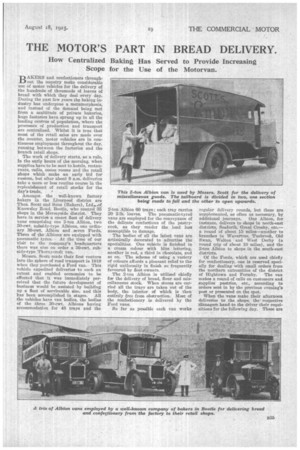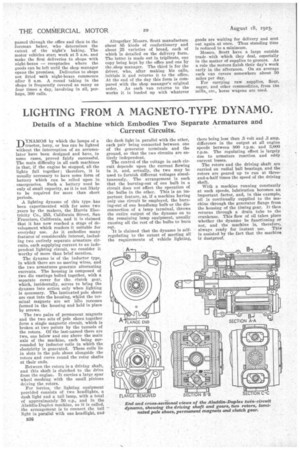THE MOTOR'S PART IN BREAD DELIVERY.
Page 19

Page 20

If you've noticed an error in this article please click here to report it so we can fix it.
How Centralized Baking Has Served to Provide Increasing Scope for the Use of the Motorvan.
BAKERS and confectioners throughout the country make considerable use of motor vehicles for the delivery of the hundreds of thousands of loaves of bread with which they deal every day. During the past few years tb.e baking industry has undergone a metamorphosis, and instead of the demand being met from a multitude of private bakeries, huge factories have sprung up in all the leading centres of population, where the processes of production and transport are centralized. Whilst it is true that most of the retail sales are made over the counter, motor vehicles are in continuous employment throughout the day, running between the factories and the branch retail shops.
The work of delivery starts, as a rule, in the early hours of the morning, when supplies have to be sent to hotels, restaurants, cafes, cocoa rooms and the retail shops which make an early bid for custom, but after about 9 a.m. deliveries take a more or legs routine course in the replenishment of retail stocks for the day's trade. • Amongst the well-known factory bakers in the Liverpool district are Thos. Scott and Sons (Bakers), Kuowsky Road, Bootle, who control 35 shops in the Merseyside district.. They have in service a smart fleet of delivery vans comprising one 2-ton Albion, two 30-cwt. subsidy-type Albions, one ordinary 30-cwt. Albion and . seven Fords. Three of the Albions are equipped with pneumatic tyres. At the time of our visit to the company's headquarters there was also on order a 30-cwt. subsidy-type Thornycroft van.
Messrs. Scott made their first venture into the sphere of road transport in 1919 when they purchased a Ford van. This vehicle expedited deliveries to such an extent and enabled economies to be effected that it was immediately perceived that the future development of business would be assisted by building up a fleet of serviceable size, and this has been accomplished in stages. All the vehicles have van bodies, the bodies of the three 30-cwt. Albions having accommodation for 48 trays and the 2-ton Albion 60 trays; each tray carries 20 2-1b. loaves. The pneumatic-tyred vans are employed for the conveyance of the delicate confections of the pastrycook, as they render the load less susceptible to damage.
The bodiea of all the latest vans are artistically decorated to advertise the specialities. One vehicle is finished in a cream colour with blue lettering, another is red, a third in chocolate, and so on. The scheme of using a variety of colours affords a pleasant relief to the rigid uniformity in finish so frequently favoured by fleet owners.
The 2-ton Albion is utilized chiefly for the delivery of bread, flour and miscellaneous stock. When stores are carried all the trays are taken out of the body, the interior of which is then entirely free from obstruction. Most of the confectionery is delivered by the Ford vans.
$o far as possible each van works
regular delivery rounds, but these are supplemented, as often as necessary, by
additional journeys. One Albion, for instance, delivers to shops in north-east districts, Seaford', Great Crosby, etc.— a round of about 15 miles—another to branches in Wavertree, Tuebrook, Old Swan, Walton and West Derby (a round trip of about 10 miles), and the 2-ton Albion to shops in the south-east districts.
Of the Fords, which are used chiefly for confectionery, one is reserved specially for dealing with small orders from the northern extremities of the district of Hightown and Formby. The van makes a round of calls on customers and supplies pastries, etc., according to orders sent in by the previous evening's post or presented on the spot.
• When the vans make their afternoon deliveries to the shops, the respective riiiinagers hand to the driver their requisitions for the following day. These are passed through the office and then to the foreman baker, who determines the extent of the night's baking. The motor vehicles start work at 5 a.m. and make the first deliveries to shops with night-boxes — receptacles where the goods can be left until the shop manager opens the premises. Deliveries to shops not fitted with night-boxes commence after 8 a.m. A round taking in the shops is frequently covered as many as four times a day, involving in all, perhaps, 300 calls. Altogether Messrs. Scott manufacture about 85 kinds of confectionery and about ,.25 varieties of bread, each of which is detailed on the delivery form. The latter is made out in triplicate, one copy being kept by the office and one by the ,shop manager. The third is for the driver, who, after making his calls, initials it and returns it to the office. At the end of the day this form is compared with the shop manager's original order. As each van returns to the works it is loaded up with whatever goods are waiting for delivery and sent out again at once. Thus standing time is reduced to a minimum.
Messrs. Scott have a large outside tradewith which they deal, especially in the matter of supplies to grocers. As a rule the motors finish their day's work early in the afternoon. On an average each van covers somewhere about 50 miles per day.
For carrying raw supplies, flour, sugar, and other commodities, from the mills, etc., horse wagons are used.




























